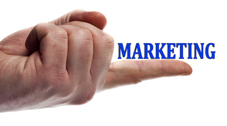Basic Steps in Branding Your Business
Mike Armour
In the previous issue I emphasized how vital it is for startups to brand themselves proactively from the very beginning. We identified three core questions which should orchestrate your branding effort.
- What does your brand promise?
- To whom does it make this promise?
- How do you go about delivering on your promise?
This article continues the discussion of branding by examining some of the tools that you use in establishing your brand.
Selecting A Good Name
Your first branding tool is the name that you choose for your business. With but one exception, you should resist the temptation to use your personal name as the business name (e.g., Thomas Jones and Associates). The exception applies to professional speakers, entertainers, atheletes, and other public figures whose personal brand and business brand are one and the same.

If you've already started a company and named it after yourself, you can always register an assumed name (or DBA) that serves your branding purposes better. I've provided guidance on assumed names on our website.
Whenever practical, the very name of your company should address at least one of the three core questions listed above. A company named "Mimi's Desserts" answers the question, "What does your brand promise?" One named "Parenting Resources, Inc." speaks to the second question, "To whom does the brand make its promise?"
Another consideration is the potential for your company name to improve Google's ranking for your website. For instance, one of my companies is Strategic Leadership Development International, Inc. A primary factor in choosing this name was to help the company website rank well when people searched for "leadership development."
Because "leadership development" is part of the company name, every mention of the company name on the website boosts my Google ranking for this critical keyword phrase.
Developing Your Tagline
Your second branding tool is your company tag line. A tag line is a brief phrase which frequently accompanies your company name or logo on business cards, web pages, brochures, or even signage. It usually highlights something unique about your company or some special benefit that your product or service bestows.

Again, your tagline serves you best when it addresses one of the three core branding questions. The tagline for Strategic Leadership Development International, Inc. is "Big Firm Quality Without Big Firm Prices." This tagline speaks to the third core question, "How do you go about delivering on your promise?" The tagline says that we deliver quality comparable to the huge leadership development firms, but at a lower cost to the client.
Another option is to word your tagline so that its language reflects back on the company name. The tagline for StartupsAfter50.com, for instance, is "A Great Time to Launch A Business." "Great Time" and "After 50" link together to form an integrated message.
One of the nice things about taglines is that they can change over time to keep your branding message more relevant and current.
Coca-Cola once had the tagline, "The Pause that Refreshes." Later, when the market became flooded with soft drink competitors, their tagline was "It's the Real Thing." Recently their website has floated out the tagline "Explore the World of Ahh."
Since taglines are so easily changed, they are a superb place to experiment with your branding message. Don't hesitate to come up with two or three different taglines for your business. Try them out in different contexts until you find the one that works best for you.
Designing A Logo
Your third branding tool is your logo. I put it third because you may want it to reflect the promise behind your company's name or the spirit of your tagline.
Through repeated exposure, your logo becomes your brand identifier in the eyes of the public. Ideally people will come to recognize your company as much by its logo as by its name. And when they see your logo, they should immediately think of your business and the promise that it makes.
A few years ago it was rather expensive to have a logo designed, too expensive for many businesses in the startup phase. But those days are long past. With just a few minutes of research you can find several online sites that provide custom logo design for very little investment.
These sites typically ask you to post a description of your company, indicate the message and feel that you want your logo to convey, and specify what you will pay for a winning submission (commonly $50 to $200). For your fee you obtain full ownership of the design you choose, with no copyright restrictions.
Three years ago my wife submitted a logo request to one of these sites, and within four days we received almost 200 proposals. One was our hands-down favorite. It captured the spirit of her venture in a way that we had not previously envisioned. Not only that, even the losing submissions sparked some ideas about how we might present her marketing message in the future.
Establishing Your Company Colors
Once you have a company name, a tagline, and a logo, you're ready to start considering your "company colors." This is more or less like the school colors that we remember from high school and college. Your stationery, web site, business cards — in short, every marketing medium — should build around the same basic color palette. This gives a uniform look to all of your branding messages.

Startups After 50 combines gray backgrounds with red and blue lettering. You see this same combination on our web page, at the top of our inbox magazine, on our Facebook page, and on our business cards.
Your color pallette is essential to a consistent branding image.Used in your marketing year after year, your colors become indelibly associated with your business identity.
Coca-Cola red has been part of Coca-Cola's branding message for a century. This particular hue of red is now so closely identified with Coke that it presents a branding challenge whenever the company tries to introduce a new drink line. A Coca-Cola bottle with a black label (as with Coca-Cola Zero) or a gray label (as with Diet Coca-Cola) just doesn't look like a Coke.
In the customer's mind these non-red labels create the same "brand disconnect" that you would have if you were to see the familiar IBM logo in purple. So choose your company colors carefully. You want to live with them for a long time.
Putting It All Together
Now, with your company name, tagline, logo, and colors defined, you're ready to design your stationery, business cards, and brochures. To create a professional appearance, you want to maintain thematic consistency across all of these marketing tools.
This means that your company name should appear in the same typeface (and preferably the same color), whether on letterhead, business cards, advertising pieces, or in the header of a webpage. The color of the logo should also be consistent across your marketing collateral.
And invest the few extra dollars to use high quality paper for your letter head and brochures and to print your business card on thick, substantial stock. This small expenditure will pay off big time in establishing you with a quality brand.
These are all "first steps." Branding also includes the content of your marketing message, the way you profile your business on its web site, and how you use social media. But these are topics for later articles. For now, attend to these basics and do them well. They are the foundation of the brand image that your business will project.
